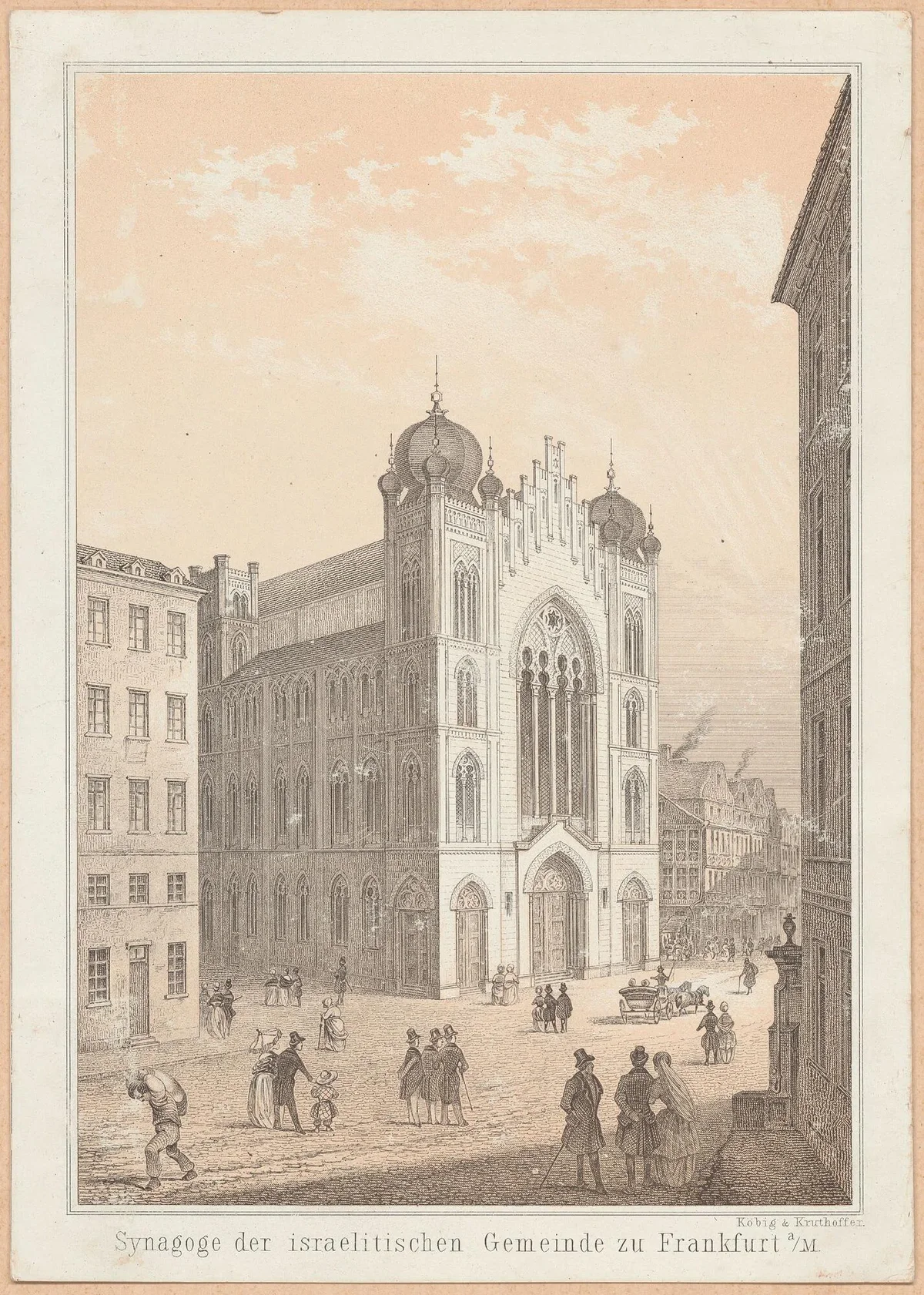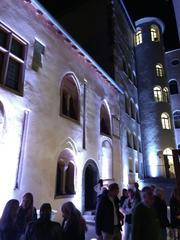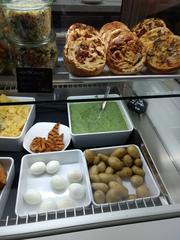
Historical Museum Frankfurt: Visiting Hours, Tickets, and Complete Visitor Guide
Date: 14/06/2025
Introduction
In the heart of Frankfurt’s Altstadt, the Historical Museum Frankfurt (Historisches Museum Frankfurt, HMF) stands as both a guardian and storyteller of the city’s rich past. Established in 1878 and housed within the ancient Saalhof complex, the museum offers a unique blend of medieval architecture and contemporary design. Visitors are treated to immersive exhibitions that trace Frankfurt’s transformation from a medieval trading post to a dynamic, multicultural metropolis. Whether you are a history enthusiast, a family traveler, or simply curious about Frankfurt’s heritage, this guide provides all essential information for your visit—including opening hours, ticketing, accessibility, highlights, and travel tips (historisches-museum-frankfurt.de; Wikipedia; ArchDaily).
Table of Contents
- Introduction & Museum Overview
- History and Significance
- Architectural Evolution and Highlights
- Permanent and Special Exhibitions
- Visitor Information: Hours, Tickets, and Accessibility
- Guided Tours, Events, and Educational Programs
- Facilities and Visitor Services
- Travel Tips and Location
- FAQs
- Conclusion & Resources
1. Museum Overview and Significance
The Historical Museum Frankfurt is the city’s oldest museum and a vital cultural institution. Its collections span over 600 years, documenting Frankfurt’s development through artifacts, models, art, and multimedia installations. Located on the Römerberg, the museum’s blend of medieval Saalhof buildings and contemporary extensions creates a compelling architectural dialogue (museumsufer.de; whichmuseum.com).
The museum not only preserves the city’s past but also serves as a forum for public engagement, inclusivity, and reflection on Frankfurt’s evolving identity.
2. History and Development
Founding and Early Years
Founded in 1878, the Historical Museum Frankfurt was envisioned as a repository for the city’s cultural memory. Originally focused on preserving medieval and Renaissance artifacts, the museum’s collections have expanded to encompass all aspects of Frankfurt’s urban and social history—making it a research center and an educational hub (Wikipedia; museum.de).
The Saalhof: A Living Relic
Since 1955, the museum has occupied the Saalhof, Frankfurt’s oldest surviving building complex, dating back to the 12th century. Renovations and modern extensions (notably in 2012 and 2017) have preserved the site’s historical essence while providing state-of-the-art exhibition spaces (frankfurt.de).
Mission and Societal Role
The museum’s mission extends beyond preservation: it seeks to foster critical reflection, public discourse, and cultural participation. Through participatory exhibitions and community projects, it positions itself as a living, inclusive institution (historisches-museum-frankfurt.de).
3. Architectural Evolution and Highlights
Saalhof Ensemble: Historic Core
The Saalhof represents centuries of architectural history, with standout buildings such as:
- Stauferbau (Staufer Building): Circa 1200, housing the Romanesque Staufer chapel.
- Rententurm (Pension Tower): A late medieval tower featuring the “Main Panorama” exhibition.
- Bernusbau and Burnitzbau: Baroque and neo-Romanesque wings, respectively, hosting galleries on city models and collectors.
- Haus zur Goldenen Waage: A Renaissance merchant’s house, accessible via guided tour (Skyline Atlas).
Contemporary Extension
Designed by Lederer Ragnarsdóttir Oei (LRO) and completed in 2017, the museum’s new wing features:
- Locally sourced red sandstone façades.
- Dramatic gable roofs echoing Frankfurt’s historic skyline.
- A spacious urban plaza and under-plaza lobby for circulation and events.
- Flexible exhibition spaces for special displays and public programs (ArchDaily; Virginia Duran).
This architectural marriage of old and new enhances the visitor experience while reinforcing the museum’s connection to the cityscape.
4. Permanent and Special Exhibitions
Permanent Exhibitions
Chronological Galleries
- Medieval Frankfurt: Exhibits housed in the Saalhof explore the city’s origins as a trading center, with archaeological finds and medieval art (museumsufer.de).
- Early Modern to 18th Century: Guild artifacts, coronation relics, and Renaissance craftsmanship, highlighted by the restored Haus zur Goldenen Waage.
- 19th Century: Focus on urban growth, industrialization, and social change—with interactive displays and multimedia.
- 1866–2001: Frankfurt’s journey from Prussian annexation, through WWII devastation, to postwar rebuilding and modernity (whichmuseum.com).
- Frankfurt Now! & Frankfurt Once?: Contemporary life and thematic explorations, using multimedia and resident stories (historisches-museum-frankfurt.de).
The Frankfurt Model
A meticulously crafted scale model of pre-war Frankfurt’s old town allows visitors to visualize the city before WWII destruction. Interactive touchscreens provide deeper exploration of specific buildings and neighborhoods.
Junges Museum and Porcelain Museum
- Junges Museum: Interactive exhibitions and workshops for children, with free admission for visitors under 18.
- Porzellan Museum: Extensive porcelain collection reflecting Frankfurt’s decorative arts heritage.
Special Exhibitions
The museum regularly curates thematic temporary exhibitions, such as:
- Move! Frankfurt and Mobility: Exploring how transport shaped the city.
- Frankfurt and Migration: Stories of diverse communities and their impact.
- Fashion Library Project: History of fashion magazines and local trends (museumsufer.de).
City Lab (Stadtlabor): A participatory platform for community-driven projects and dialogue on urban issues.
Digital Initiatives
The museum offers a multimedia guide and the “Frankfurt History App,” providing digital tours and linking museum exhibits with city landmarks (historisches-museum-frankfurt.de).
5. Visitor Information: Hours, Tickets, and Accessibility
Opening Hours
- Tuesday to Sunday: 11:00 AM – 6:00 PM
- Closed on Mondays
- Porcelain Museum: Saturdays & Sundays, 11:00 AM – 6:00 PM
- Note: Check official visiting hours for seasonal or holiday changes.
Admission and Ticketing
- Permanent Exhibitions: €8 (reduced €4)
- Temporary Exhibitions: €10 (reduced €5)
- All Exhibitions Day Ticket: €12 (reduced €6)
- Children/Youth (under 18): Free
- Groups (20+): Reduced rates
- Guided Tours: Entry plus €3
- Media Guide Rental: €3
Tickets can be purchased at the museum or in advance through the online ticket shop.
Accessibility
- Fully wheelchair accessible with elevators and ramps.
- Accessible restrooms throughout.
- Assistance for visitors with disabilities available upon request.
- Multimedia guides and resources for visitors with visual/hearing impairments.
6. Guided Tours, Events, and Educational Programs
- Guided Tours: Available in multiple languages for a €3 supplement. Topics include medieval Frankfurt, migration, and WWII.
- Goldene Waage: Accessible only by guided tour.
- Workshops & City Walks: Offered for families, school groups, and adults.
- Junges Museum: Hands-on children’s exhibitions and workshops.
- Events: Lectures, cultural evenings, and participatory City Lab projects.
Advance booking is recommended for all tours and workshops (museum’s booking page).
7. Facilities and Visitor Services
- Lockers: Free for large bags (required for exhibition entry).
- Café: Refreshments and light meals, ideal for a break.
- Museum Shop: Books, souvenirs, and educational materials.
- Restrooms: Accessible on all floors.
8. Travel Tips and Location
Address: Saalhof 1, 60311 Frankfurt am Main, Germany
Getting There:
- Public Transport: U-Bahn (U4, U5) to Dom/Römer; trams 11, 12, 14 to Römer/Paulskirche.
- By Car: Parking at Dom/Römer or Römer garages; use public transport if possible due to central location.
Nearby Attractions: Römer City Hall, Frankfurt Cathedral, Städel Museum, Museumsufer, Alt-Sachsenhausen.
Visit Duration: Allow 2–3 hours for a thorough visit.
Tips:
- Purchase tickets online to avoid queues.
- Visit on weekday mornings for fewer crowds.
- Use the media guide for richer insight.
- Photography is permitted for personal use (no flash/tripods).
9. Frequently Asked Questions (FAQs)
Q: What are the museum’s opening hours?
A: Tuesday to Sunday, 11:00 AM–6:00 PM; closed Mondays.
Q: How can I buy tickets?
A: At the museum or online via the official ticket shop.
Q: Is the museum wheelchair accessible?
A: Yes, with elevators, ramps, and accessible restrooms.
Q: Are guided tours available?
A: Yes, in multiple languages for an additional fee.
Q: Can I bring children?
A: Yes, under-18s enter free, and the Junges Museum offers activities for young visitors.
Q: Is there a café and shop onsite?
A: Yes, both are available for visitors.
10. Conclusion & Resources
The Historical Museum Frankfurt offers an enriching journey through the city’s history, from its medieval roots to its vibrant present. With its central location, accessible facilities, and engaging exhibitions, the museum is a must-see for visitors of all ages. Enhance your experience with guided tours, digital resources, and participatory events. For the latest information on hours, tickets, and programming, always consult the official museum website.
Enhance your visit by downloading the Audiala app for guided audio tours and updates. Stay connected through the museum’s social media channels, and explore related articles on Frankfurt’s cultural sites for a comprehensive travel experience.
References
- Historical Museum, Frankfurt, 2023, Wikipedia
- Historical Museum Frankfurt, 2024, Official Museum Website
- Historical Museum Frankfurt, 2024, Museumsufer Frankfurt
- Historical Museum Frankfurt, 2024, WhichMuseum
- Historical Museum Frankfurt, 2024, ArchDaily
- Skyline Atlas, 2024, Historical Museum Frankfurt Architecture
- Destination WWII, 2024, WWII Sites in Frankfurt
- Virginia Duran, 2023, Frankfurt Architecture Highlights









































